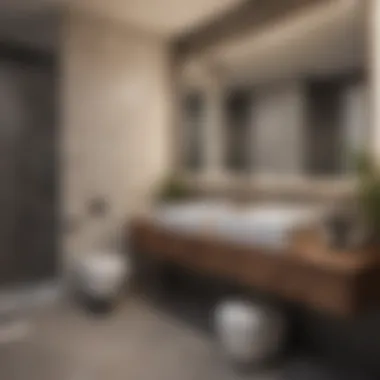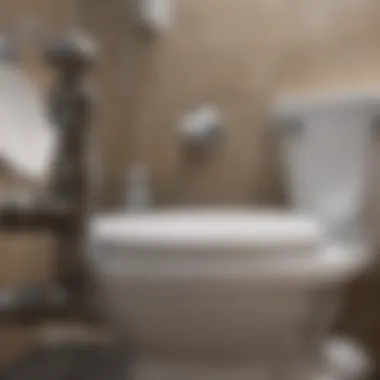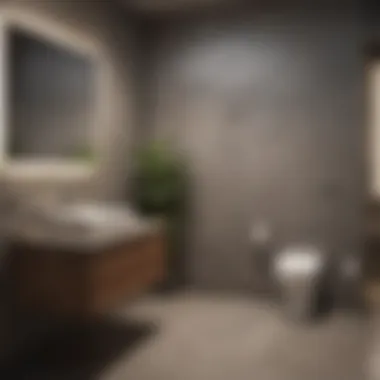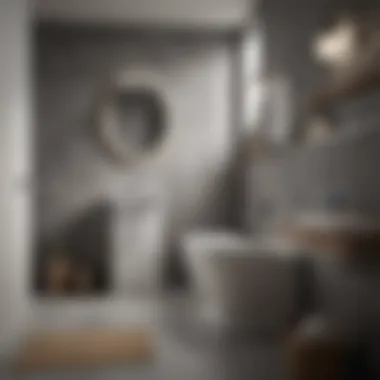Understanding the Costs of Installing a Toilet and Sink


Intro
Installing a toilet and sink often seems like a straightforward task, yet the complexities involved can lead to significant costs. Homeowners may not fully grasp the various factors that influence expenses until they delve into the details of their project. This article will guide you through essential considerations, helping refine your decision-making process for bathroom renovations or new constructions.
Understanding the costs associated with these installations is crucial for several reasons. Firstly, it prevents unexpected financial surprises. Secondly, it empowers you with the knowledge needed to evaluate quotes from contractors. Furthermore, it fosters informed choices regarding materials, styles, and layout options to maximize both functionality and aesthetics in your bathroom design.
As we explore the costs of installing a toilet and sink, we will examine critical elements such as:
- Labor costs and the distinction between DIY and professional installation.
- Variations in plumbing configurations.
- Costs associated with different types of toilets and sinks.
- The potential financial implications of permits and inspections.
By gaining insights into these factors and considering the associated costs thoroughly, homeowners can engage proactively with contractors and craftspeople. Such engagement can lead to better quality work and ultimately, a satisfying outcome.
Preamble to Installation Costs
Understanding the costs associated with installing a toilet and sink is crucial for any homeowner or renovation enthusiast. These installations are essential components of a functional bathroom. They require careful planning and budgeting to ensure long-term satisfaction and efficiency. By comprehensively understanding these costs, individuals can make informed decisions that align with their financial capacity and design goals.
The factors influencing installation costs can be numerous. From the type of fixtures chosen to the local labor market, every element plays a role. Additionally, the existing plumbing infrastructure could greatly impact overall expenses. Knowledge about these factors not only helps in budgeting but also enables homeowners to anticipate potential challenges during installation.
Thus, this section sets the foundation for what follows. A clear understanding of installation costs can lead to better planning, ensuring that renovations go smoothly and that the results meet expectations.
Overview of Bathroom Installations
Bathroom installations often represent one of the more significant investments within a home renovation project. The process can involve multiple elements beyond just the toilet and sink, including plumbing, flooring, and even lighting considerations. Each of these aspects contributes to the overall expense and timeline of the renovation.
It’s essential to approach bathroom installation projects with a strategic mindset. Proper assessment of existing conditions is fundamental for an accurate understanding of overall costs. Commonly, homeowners will need to decide between upgrading existing fixtures or opting for entirely new installations. Each choice has implications for cost, style, and practicality.
Moreover, understanding trends in bathroom design can also influence choices. Fixtures like the Kohler Cimarron toilet or the Moen Arbor sink provide examples of popular selections that combine functionality with aesthetic appeal. This potential for variety underscores the necessity for thorough research and planning.
In summary, an overview of bathroom installations gives readers crucial insight into how installation costs accumulate. Awareness of all components involved paves the way for more effective budgeting and ensures a smoother renovation experience.
Factors Influencing Installation Costs
Understanding the factors influencing installation costs is crucial for homeowners embarking on bathroom renovations or new constructions. The financial aspects can vary significantly based on several elements. Recognizing these variables helps in making informed decisions and budgeting effectively.
Type of Fixtures
The choice of fixtures has one of the most significant impacts on installation costs. Toilets and sinks come in various styles, brands, and technologies. For example, low-flow toilets are designed to conserve water, which may lead to higher upfront costs but save money in the long run. Conversely, more affordable models might save money initially but incur higher water bills. Sinks also vary; for instance, vessel sinks typically cost more to install than standard drop-in models due to the complexity of fitting them. Homeowners should weigh the long-term benefits against the initial costs when selecting fixtures.
Labor Costs
Labor costs can be another considerable factor in the total installation expense. Professional plumbing services vary widely depending on expertise and location. Generally, charges are higher in urban areas compared to rural settings. Additionally, the experience of the plumber plays a role. Highly experienced professionals may charge more but often provide better quality work and ensure compliance with local plumbing codes. Homeowners should receive multiple quotes and inquire about the scope of work to better understand the labor component of their installation.
Location of Installation
The location of installation also influences costs. Bathrooms on upper floors may require additional labor and materials to manage plumbing efficiently compared to those at ground level. Furthermore, accessibility affects installation complexity. If the plumbing infrastructure is difficult to access, labor costs will likely increase as tasks can take longer to complete. Considerations of the room layout, size, and existing features all contribute to how much will be spent on installation.
Existing Plumbing Infrastructure
The state of existing plumbing infrastructure is another critical factor to consider. If renovations demand alterations to old pipes or connections, this could escalate costs. Homeowners may need to invest in rerouting plumbing lines or replacing outdated fixtures, which adds to material and labor expenses. An inspection of the current plumbing system provides a clearer picture of potential additional costs and necessary updates.
Permitting and Code Compliance
Finally, permitting and compliance with local building codes cannot be overlooked. Many regions require homeowners to secure permits for significant plumbing work. The process can entail costs for applications, as well as added time for inspections. Failing to adhere to local building regulations might lead to fines or the necessity to redo work, resulting in wasted money and time. It is prudent for homeowners to familiarize themselves with these regulations prior to starting any installation work.
Cost Breakdown for Toilet Installation


Understanding the costs associated with toilet installation is critical for homeowners who plan to renovate or construct bathrooms. The Cost Breakdown for Toilet Installation provides a detailed insight into the various components that contribute to the overall expenses. This analysis aids in budgeting accurately and allows for better decision-making regarding fixture selection and professional assistance. Homeowners can identify potential savings while ensuring that the installation meets their needs, all while adhering to local plumbing codes.
Average Prices for Toilets
The price of toilets can vary widely based on brand, model, and features. On average, consumers can expect to pay between $120 to $600 for a toilet unit itself. Factors influencing this price include:
- Type of Toilet: Standard toilets usually cost less than high-efficiency or luxury models.
- Brand Reputation: Well-known brands may charge a premium for reliability and warranty.
- Special Features: Advanced features like heated seats and self-cleaning options can inflate costs.
When shopping, it is essential for homeowners to consider not just the sticker price but also the long-term benefits such as water conservation which can lead to lower utility bills.
Installation Labor Costs
Labor costs form a significant part of the overall expense in toilet installation. Typically, plumbers charge an hourly rate ranging from $45 to $150, depending on their location and experience. Installation can take 1 to 4 hours, depending on the complexity. Key considerations include:
- Location: Urban areas generally have higher labor costs compared to rural regions.
- Accessibility: If the installation site has limited access or requires extensive modifications, costs may increase.
- Experience Level: Skilled professionals may charge more, but their expertise can prevent future issues.
It is prudent to obtain multiple quotes and check references before hiring a plumber to ensure a fair price.
Potential Additional Fees
In addition to the price of the toilet and labor costs, there may be several additional fees to consider:
- Removal of Old Toilet: Many contractors charge extra for removing and disposing of the existing unit.
- Minor Plumbing Repairs: If issues are found during installation, such as leaks or damaged pipes, repairs will add to costs.
- Permit Fees: Some localities require permits for plumbing work, which can range from $20 to $100.
It is crucial for homeowners to budget for these potential additional expenses to avoid surprises.
By understanding each of these components, homeowners can gain context for the total cost of toilet installation. This comprehensive awareness permits more informed decisions in their renovation efforts.
Cost Breakdown for Sink Installation
The cost breakdown for sink installation is a vital aspect of this article. Understanding how much you might spend is crucial for homeowners and design enthusiasts. It allows for more informed decisions, better budget management, and can help in comparing costs with toilet installations. A detailed breakdown aids in identifying potential costs that could arise during the installation process, including aspects many may overlook.
Average Prices for Sinks
The average prices for sinks can vary based on several factors, including materials and styles. Common materials include ceramic, stainless steel, and porcelain. Ceramic sinks tend to be among the most affordable, often ranging from $50 to $400. Stainless steel sinks are slightly higher in price, typically falling between $100 and $600, depending on the quality. For more luxurious options, undermount or farmhouse sinks can be considerably pricier, often starting from $300 and reaching upwards of $1,200.
Another important factor is the sink's style. For instance, a single bowl sink usually costs less compared to a double bowl design.
Supplementary costs for accessories, such as faucets and drain assemblies, should also be factored in. Overall, the total budget should include the cost of the sink itself alongside these additional items to get an accurate financial picture.
Installation Labor Costs
Labor costs play a significant role in the overall expense of sink installation. The professional installation typically ranges from $150 to $500. This range depends on various factors, including the complexity of the installation and the prevailing local rates.
Some considerations include:
- Location of installation: Urban areas may see higher labor costs.
- Installation complexity: Installing a new sink where plumbing already exists will usually cost significantly less than a complete installation requiring new pipes.
- Hourly rates: Many professionals charge by the hour, which can vary significantly across regions.
When hiring a contractor, requesting multiple quotes is advisable. This helps in making a cost-effective decision while ensuring quality work.
Potential Additional Fees
When planning for sink installation, it is prudent to consider potential additional fees that might arise during the process.
Some common additional fees include:


- Permitting costs: Depending on the local regulations, a permit may be required, which can add $20 to $100 to your budget.
- Plumbing modifications: If existing plumbing needs to be modified, expect extra charges. This can vary widely based on the extent of work required.
- Additional fixtures: Purchasing new faucets or sinks may sometimes require add-ons like mounting kits or plumbing adapters, which can range from $20 to $200.
It is wise to set aside around 10-20% of your overall budget to cover unforeseen expenses that might arise during the installation process.
Choosing Between DIY and Professional Installation
Choosing whether to install a toilet and sink yourself or hire a professional is a significant decision. It impacts not only the costs involved but also the overall satisfaction with the installation. Homeowners who consider DIY often think it saves money. However, there are crucial aspects to weigh before deciding. Professional installations can offer quality assurance, while DIY tends to be more flexible in terms of timing and personal effort.
When looking at DIY installation, one must evaluate personal skills, available tools, and time commitment. A well-executed DIY project can indeed save both money and provide a sense of accomplishment. However, the risks of complications can lead to larger problems down the road. Therefore, understanding the pros and cons deeply can lead to more informed decisions about installation preferences.
When hiring professionals, the benefits often outweigh the costs involved. A qualified plumber has the knowledge and experience to navigate complicating plumbing structures, ensure compliance with local codes, and provide a warranty for their work. This can create peace of mind that is often worth the expense.
Pros and Cons of DIY Installation
Pros:
- Cost Savings: Doing it yourself usually means no labor costs, only materials.
- Control Over the Process: You have the freedom to choose the timing and methods.
- Personal Satisfaction: Completing a project on your own can be fulfilling.
Cons:
- Time Consuming: DIY can take much longer than expected, especially for those with little experience.
- Skill Requirements: Installing toilets and sinks requires specific skills, which may lead to challenges.
- Risk of Errors: Mistakes can result in costly repairs or damages, negating initial savings.
When to Hire a Professional
Knowing when to hire a professional can save homeowners from potential headaches. If there are existing plumbing issues, such as leaks or inadequate water pressure, consulting a plumber becomes essential. Also, if the installation location requires alterations to existing plumbing, a professional's expertise is beneficial.
If a homeowner lacks the necessary tools or skills to perform the installation correctly, hiring a professional is very wise. Most importantly, if the project requires adherence to local building codes, a professional will ensure compliance, avoiding costly fines later.
In essence, recognizing the complexities of the project is key. Homeowners should not hesitate to consult professional services when in doubt, valuing safety and quality over potential short-term savings.
Common Issues and Challenges
Understanding the common issues and challenges in toilet and sink installation is crucial for homeowners. These challenges can lead to unexpected costs and project delays when not properly addressed. Recognizing the potential pitfalls can help in planning, budgeting, and executing a smooth installation process.
Plumbing Problems
When installing a toilet or sink, plumbing problems can frequently arise. One of the most common issues is incompatible plumbing fittings. For instance, different types of plumbing may have varying sizes and connection styles, leading to leakage if not matched correctly. Homeowners should inspect existing plumbing infrastructure before purchasing new fixtures.
In some cases, old pipes may need replacement due to corrosion or wear. This can significantly increase the overall cost of the installation process. Homeowners must factor in this potential expense when considering the budget.
Additionally, improper drainage systems can cause significant problems. Toilets and sinks rely on effective drainage to function correctly. If drainage is compromised, it can lead to backups and unpleasant odors. This can also necessitate professional assistance to resolve the issue, adding to the budget.
Design Compatibility Issues
Design compatibility is another critical consideration when installing a toilet and sink. Not all fixtures will fit every bathroom layout. Homeowners must examine their bathroom design to ensure the selected fixtures blend well with the overall aesthetic and functionality.
For example, a modern sink in a traditional bathroom may look out of place. Similarly, the dimensions of the space can limit fixture choices. A large toilet may not fit comfortably in a small bathroom, leading to extra alterations or redesigns. These adjustments can add unforeseen expenses and complexity.
Furthermore, fixtures should not only match aesthetically but also functionally. A deep sink may look appealing, but if it doesn't work with the existing plumbing, it will not fulfill its purpose.
It is essential to check dimensions and compatibility before purchasing new fixtures to avoid costly mistakes.
By understanding these common issues, homeowners can approach toilet and sink installation with better preparedness and confidence. Awareness of plumbing and design challenges allows for a more successful renovation or construction project.
Long-term Considerations


When thinking about the costs of toilet and sink installation, long-term considerations should be at the forefront of decision-making. These elements not only influence initial spending but also impact the longevity and reliability of installations in residential bathrooms.
Maintenance Costs
Maintenance costs represent a crucial factor in the long-term functionality of bathroom fixtures. Toilets and sinks require regular upkeep to ensure they remain in good working order. Common maintenance tasks include checking for leaks, ensuring proper flushing mechanisms, and regularly cleaning to prevent build-up.
If homeowners neglect these tasks, repair expenses can escalate. For example, ignoring a small leak can lead to water damage, requiring costly repairs. It is advisable to budget for annual maintenance inspections that may cost anywhere from $50 to $200 depending on the complexity of the systems.
Here are several tasks that can help in keeping sinks and toilets well-maintained:
- Regularly check for leaks and repair them promptly.
- Clean drains to prevent clogs and backups.
- Inspect seals around sinks and toilets for wear or damage.
- Monitor water pressure and flow rates for signs of trouble.
Replacement Timelines
Replacement timelines should also be factored into the overall costs. Toilets typically last about 10 to 15 years, while sinks may have a longer lifespan, averaging 15 to 20 years based on usage and quality. However, several aspects can determine when a replacement is necessary. The condition of the plumbing, frequency of repairs, and aesthetic changes in design could necessitate earlier replacements than expected.
Planning ahead for these expenses is wise. Homeowners should consider the potential replacement costs as part of their long-term strategy. Here’s an overview of what to monitor as fixtures age:
- Performance degradation: Toilets that struggle to flush properly or sinks that drain slowly may need replacing sooner.
- Visual wear: Cracked porcelain in toilets or rusted metal in sinks often indicates the need for a new fixture.
- Changing styles: Renovations or updates in design trends may prompt desires to replace an otherwise functional fixture.
Comparative Analysis: Toilet vs. Sink Installation Costs
A comparative analysis of toilet and sink installation costs offers invaluable insights for homeowners. Understanding the financial implications of both options helps in making critical decisions during renovations or new constructions. Not only does this comparison inform budgeting, but it also sheds light on the potential value each fixture adds to a home.
Overall Expense Comparison
When considering the overall expenses of installing a toilet versus a sink, it is essential to account for various factors.
- Average Costs: Generally, toilet installations can range between $150 and $500 for the fixture alone, depending on the model and brand. For sink installations, the costs can vary more significantly. Basic models can start around $70, while designer sinks may go beyond $1,000.
- Labor Charges: Installation labor is another aspect to consider. Plumber charges for installing a toilet can be around $100 to $300, influenced by regional rates and the complexity of the installation. Sink installation may incur similar or slightly higher labor fees, particularly if additional plumbing work is required for faucets or drainage.
"Understanding accurate costs for both toilets and sinks can help homeowners allocate their renovation budget more effectively."
- Additional Fees: Both types of installations may incur unexpected fees. For toilets, existing plumbing issues might necessitate extra repairs, leading to increased costs. With sinks, particularly if they are part of a vanity or involve more complex cabinetry, the likelihood of unforeseen expenses also rises.
In summary, while toilets may generally have lower upfront costs, sinks can vary more widely in price. This requires careful consideration of both fixture type and installation scope to ensure budgeting reflects the homeowner's intentions.
Value for Money Considerations
Assessing value for money is crucial when choosing between toilet and sink installations. This evaluation can guide homeowners toward decisions that enhance their living spaces.
- Durability and Longevity: Toilets tend to have a long lifespan, often lasting between 15 to 30 years with proper maintenance. Sinks, depending on the material, may also last long, yet factors like usage and wear can affect their longevity.
- Functionality and Utility: A toilet is essential for day-to-day life, influencing decisions towards practicality. Sinks, on the other hand, serve both functionality and aesthetic purposes. A well-chosen sink can act as a centerpiece in a bathroom or kitchen, increasing a home's value.
- Home Value Impact: When evaluating property value, a functional and stylish bathroom can significantly enhance home appeal. Investing in a higher-quality sink could yield returns higher than similar investments in toilets, especially in competitive markets.
The End and Recommendations
In discussing the costs associated with installing a toilet and sink, several important elements emerge. Understanding these costs is crucial for homeowners who wish to make informed decisions regarding their bathrooms. A thorough comprehension of the expenses involved can lead to enhanced project planning and budgeting.
When considering installation, remember that various factors influence the total cost. Knowledge about the type of fixtures needed, labor charges, and the existing plumbing infrastructure helps to create a clearer picture of potential expenses. Moreover, homeowners should not underestimate the value of permits and ensuring compliance with local codes, as these can impact both budget and installation timeline.
One key benefit of this understanding is the ability to make more informed choices between DIY installations versus hiring professionals. The risks of underestimating the complexity of installations can be significant. Being aware of common challenges, like plumbing issues or design compatibility, can save you from costly mistakes down the line.
Overall, a comprehensive consideration of these topics allows homeowners to approach their projects with a proactive mindset. By navigating through the anticipated costs and challenges effectively, you can acquire both a functional and aesthetically pleasing bathroom space.
Summary of Key Points
- Understanding Installation Costs: Assessing all financial aspects can lead to better budgeting for renovations.
- Factors Influencing Cost: Different types of fixtures, labor costs, and plumbing situations significantly affect overall expenses.
- DIY vs. Professional Help: Knowing when to seek outside expertise can minimize risks and enhance the project's success.
- Long-term Value: Assessing both initial and long-term costs can lead to more sustainable decisions regarding fixtures and installation methods.
Next Steps for Homeowners
- Conduct Research: Begin by researching available fixtures and their costs. Compare brands and models for quality and pricing.
- Evaluate Existing Plumbing: Analyze your current plumbing setup. Identification of potential challenges can aid in better planning.
- Consult Professionals: Engage with licensed plumbers and contractors to gain insights on the specific infrastructure of your bathroom and associated costs.
- Create a Budget: Outline a detailed budget based on gathered information that includes all potential expenses, such as labor and materials.
- Plan for the Future: Consider ongoing maintenance costs and the lifespan of chosen fixtures to ensure they meet long-term needs.
By following these steps, homeowners can enhance their knowledge and navigate the complexities of bathroom installations effectively.



